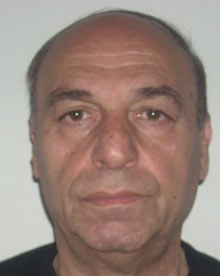Un processo in corso in Georgia, tenuto piuttosto segreto, rivela l’incubo: uranio arricchito, ideale per costruire bombe atomiche, veniva smerciato al mercato nero. Intercettati due armeni che trafficavano, uno è un uomo d’affari, Sumbat Tonoyan, l’altro un fisico (qui nella foto del Guardian), Hrant Ohanian. La rivelazione è del Guardian del 7.11.2010:
Nuclear bomb material found for sale on Georgia black market
Exclusive: Georgia trial reveals how sting netted highly enriched uranium that had been smuggled via train inside lead-lined cigarette box
Julian Borger in Tbilisi guardian.co.uk, Sunday 7 November 2010 16.57 GMT
Highly enriched uranium that could be used to make a nuclear bomb is on sale on the black market along the fringes of the former Soviet Union, according to evidence emerging from a secret trial in Georgia.
Two Armenians, a businessman and a physicist, have pleaded guilty to smuggling highly enriched uranium (HEU) into Georgia in March, stashing it in a lead-lined package on a train from Yerevan to Tbilisi.
Georgia’s president, Mikheil Saakashvili, informed other heads of state of the sting operation at a nuclear summit in Washington in April, but no details about the case have been made public until now. The trial has been conducted behind closed doors to protect the operational secrecy of Georgia’s counter-proliferation unit, officials said. But investigators have given the Guardian an exclusive first-hand account of the case.
It reveals that the critical ingredient for making a nuclear warhead is available on the black market and is reasonably easy to smuggle past a ring of expensive US-funded radiation sensors along the borders of the former Soviet Union. What is not clear is how much nuclear material is in circulation and whether any has already been bought by extremist groups.
The US has made the prevention of nuclear terrorism its national security priority. Barack Obama persuaded 50 world leaders at the April summit to pledge to secure all vulnerable nuclear material within four years.
Billions of dollars have been spent upgrading security at nuclear sites around the globe, particularly in Russia, which has an estimated 700 tonnes of HEU in hundreds of facilities. But it is unclear how much has already been stolen. “The question is: of what iceberg are we seeing the tip?” said Matthew Bunn, a Harvard expert and former White House science adviser, who compiles an annual assessment of the nuclear terrorism threat titled Securing the Bomb.
The uranium sample that Sumbat Tonoyan and Hrant Ohanyan were peddling is thought to have been stolen several years ago. US tests have confirmed it is 89.4% enriched, usable in a nuclear warhead. The Armenians only had 18 grams, but had been told by their supplier in Armenia that much more was available. They smuggled it into Georgia by train in a cigarette box lined with lead to fool radiation sensors at the border. Tonoyan, a 63-year-old who once ran a successful dairy business but gambled away his fortune, and Ohanyan, a 59-year-old scientist at the Yerevan Institute of Physics, had arranged to meet their buyer in a hotel in the Georgian capital on 11 March. They thought they were selling their 18g sample to a representative of an Islamist group as a precursor to a bigger consignment. But the buyer was an undercover police officer.
It is the third time in seven years HEU has been intercepted in Georgia. There have been 21 seizures or attempted thefts of weapons-grade material, uranium or plutonium, in the region since the Soviet Union collapsed. In every case the material seized had not been missed and mostly the theft was by an insider.
“There has never been a good physical inventory. Accounting rules in the Soviet Union were not designed with an internal threat in mind,” said Elena Sokova, of the Monterey Institute of International Studies. “No one registered that this material was missing and we still don’t know whether other material went missing.”
In the three Georgian cases, there is some evidence linking the stolen HEU to a nuclear fuel plant in Novosibirsk, Siberia. Garik Dadayan, the smuggler involved in the first case in 2003, was found to have gone to Novosibirsk, before trying to smuggle about 200g of HEU into Georgia.
The smuggler in the second case, Oleg Khintsagov, also initially claimed he acquired his HEU from business acquaintances in Novosibirsk, although he later changed his account. Ohanyan and Tonoyan say they got their sample from Dadayan, who was released in 2005.
Tense Georgia-Russian relations since a short war in 2008 have made it impossible to trace the material to its source.
“Most likely, the materials were stolen in the mid- or early 1990s when a big amount of material disappeared. It’s hidden somewhere and from time to time, someone is trying to find new buyers,” said Archil Pavlenishvili, head of Georgia’s radioactive materials investigation team. “We think that the game is not over. There will be more attempts.”
What is highly enriched uranium?
What is HEU?
The level of enrichment in uranium refers to the concentration of U-235, its most fissile isotope. The higher the concentration the easier it is to trigger a chain reaction. Highly enriched uranium (HEU) refers to anything above 20%.
What does weapons-grade mean?
To make a nuclear weapon small enough to transport anywhere, you need HEU that is about 90% enriched.
How much weapons-grade uranium do you need to make a bomb?
It depends what kind of bomb you are making – but to build a crude device you would need about 50kg (110lbs) to achieve critical mass. You can also make a bomb out of plutonium, but such a bomb is harder to build, and it is more dangerous to handle.
How easy is it to smuggle?
It is surprisingly easy and safe to handle. It is so mildly radioactive that small amounts can be held with bare hands or smuggled in an ordinary bag. A minimal amount of shielding, with lead for example, would stop it triggering a radiation sensor.
How much is unaccounted for?
Nobody knows, but in the chaos following the collapse of the Soviet Union, hundreds of tons of HEU was kept in hundreds of sites, some with absurdly little security. In one case, a Russian naval officer walked through a hole in the fence at a military base, snapped the padlock on a shed, put several kilograms of HEU in his backpack, before walking out unchallenged. A military prosecutor concluded that “potatoes were guarded better”.


